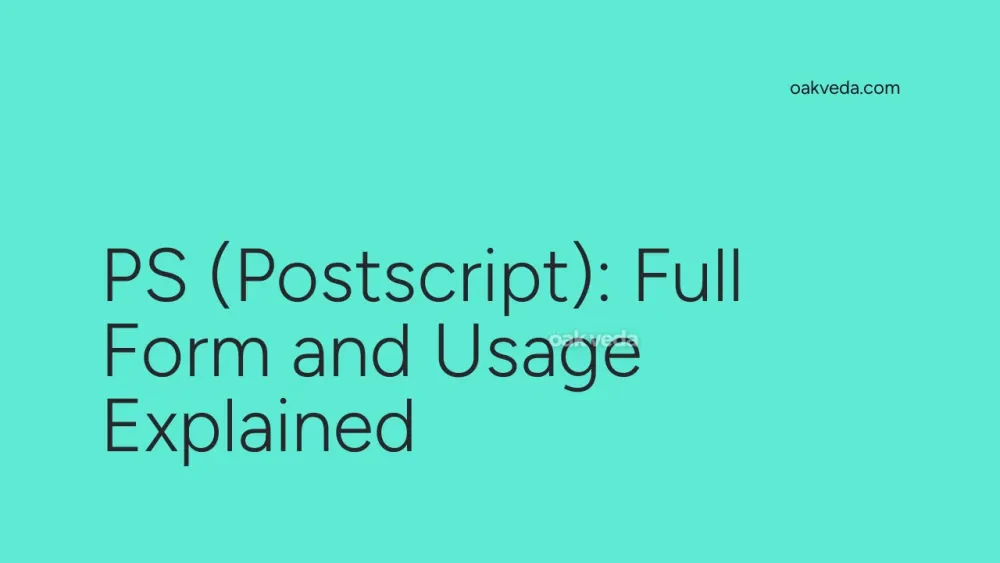
What is the Full Form of PS?
PS is the abbreviation for Postscript. This term is commonly used in written communication to add additional information or thoughts after the main body of a message has been completed and signed.
What is Postscript?
Postscript is a supplementary message or thought added to a letter, email, or other forms of written communication after the writer has finished and signed the main content. It serves as a way to include information that was forgotten or to emphasize a particular point without disrupting the flow of the primary message.
Origin and Development of Postscript
The term "postscript" originates from the Latin phrase "post scriptum," which literally translates to "written after." This practice has been in use for centuries, dating back to the time when handwritten letters were the primary form of long-distance communication. As writing technologies evolved, the use of postscripts adapted to new mediums while maintaining its core purpose.
How does Postscript work?
Postscript functions as an addendum to the main body of a written piece. Here's how it typically works:
- The writer completes the main content of their message
- They sign or conclude the piece as usual
- If additional information needs to be added, the writer includes "PS" followed by the extra content
This structure allows the writer to maintain the integrity of the original message while still conveying important afterthoughts or additional information.
Functions of Postscript
Postscript serves several important functions in written communication:
- Adding forgotten information: It provides a space to include details that were overlooked in the main body of the message.
- Emphasizing key points: Writers can use a postscript to reiterate or highlight crucial information.
- Injecting humor or personal touch: PS can be used to add a lighthearted comment or personal note, especially in formal communications.
- Updating information: In time-sensitive communications, a postscript can provide last-minute updates or changes.
Applications of Postscript
Postscript is versatile and can be applied in various forms of written communication:
- Emails: Adding a PS at the end of an email is common in both personal and professional correspondence.
- Letters: Traditional letters often include postscripts for additional thoughts or information.
- Websites: Content creators may use PS in blog posts or articles to add disclaimers or extra notes.
- Marketing materials: Advertisers sometimes use PS in sales letters to emphasize key selling points or special offers.
- Books and essays: Authors might include a postscript to provide updates or additional context after the main work is completed.
Features of Postscript
Key features of postscript include:
- Brevity: PS is typically concise, often limited to a sentence or short paragraph.
- Flexibility: It can be used for various purposes, from adding crucial information to injecting humor.
- Attention-grabbing: The PS often stands out visually, drawing the reader's attention.
- Informality: Even in formal communications, a PS can add a touch of personal connection.
Benefits of Using Postscript
Incorporating postscript in your writing can offer several advantages:
- Improved clarity: It allows you to clarify or expand on points without disrupting the main message.
- Enhanced memorability: Information in a PS is often remembered better due to its distinct position.
- Increased engagement: A well-crafted PS can encourage reader interaction or action.
- Flexibility in communication: It provides a way to add time-sensitive information without rewriting the entire message.
Limitations or Challenges of Postscript
While postscript is a useful tool, it does have some limitations:
- Overuse: Relying too heavily on PS can make your writing appear disorganized or poorly planned.
- Length constraints: Postscripts are expected to be brief; lengthy additions may be better incorporated into the main text.
- Formality concerns: In highly formal documents, frequent use of PS might be seen as unprofessional.
Future Developments in Postscript Usage
As digital communication continues to evolve, the use of postscript is adapting:
- Digital signatures: With the rise of e-signatures, the placement and format of PS in digital documents may change.
- Interactive PS: In digital media, PS might become clickable or expandable, offering more detailed information on demand.
- AI-assisted PS: Future writing tools might suggest relevant postscripts based on the content of the main message.
FAQs on PS Full Form
-
Is it correct to use multiple postscripts in a single message? Yes, you can use multiple postscripts. They are typically labeled as PS, PPS (Post-Postscript), PPPS, and so on.
-
Should PS be capitalized? While both "PS" and "P.S." are acceptable, the capitalized version without periods (PS) is more common in modern usage.
-
Can I use PS in formal business communications? While PS is generally acceptable in most business communications, use it judiciously in highly formal documents.
-
Is there a difference between PS and NB? Yes, PS (Postscript) is for additional thoughts after the main message, while NB (Nota Bene, meaning "note well") is used to draw attention to an important point within the main text.
-
How long should a postscript be? Ideally, a postscript should be brief—usually a sentence or short paragraph. Longer additions might be better incorporated into the main body of the text.
By understanding the full form and proper usage of PS, you can enhance your written communication, ensuring that all your important thoughts are effectively conveyed to your readers.
You may be interested in:

